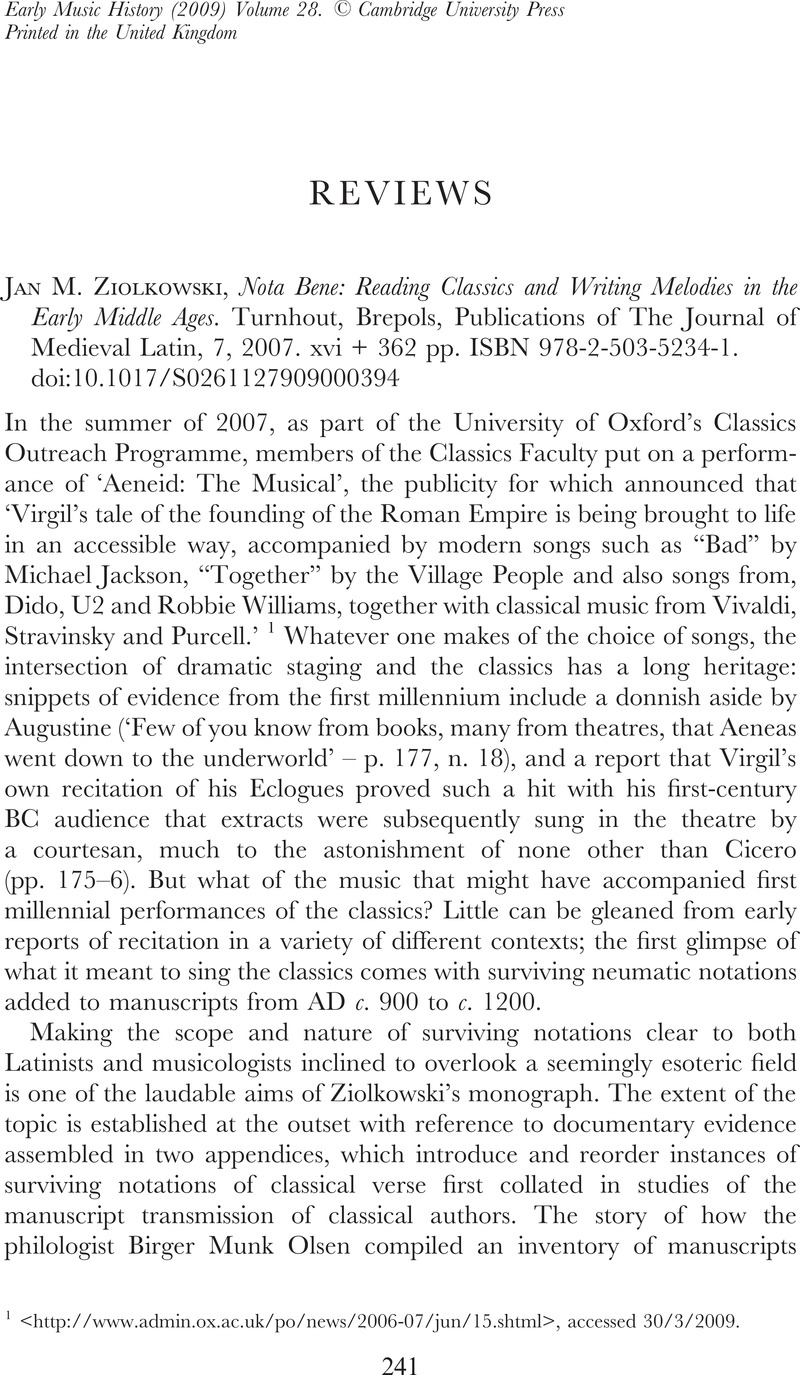Published online by Cambridge University Press: 24 August 2009

1 See Robert L. Kendrick, The Sounds of Milan, 1585–1650 (Oxford and New York, 2002) and Miguel A. Marín, Music on the Margin: Urban Musical Life in Eighteenth-Century Jaca (Spain) (Kassel, 2002).
2 Juan Carlos Estenssoro, ‘Música, discurso y poder en el régimen colonial’, 3 vols. (MA diss., Pontificia Universidad Católica del Perú, 1990), and Bernardo Illari, ‘Polychoral Culture: Cathedral Music in La Plata (Bolivia), 1680–1730’, 4 vols. (Ph.D. diss., University of Chicago, 2001).
3 Illari, ‘Polychoral Culture’, i, p. 273. Discussed in further detail in ‘Corpus Christi in Cusco: The Musical Image of a Latin American Baroque City’, CD booklet, Corpus Christi à Cusco, Ensemble Elyma & Schola Cantorum Cantate Domino, dir. Gabriel Garrido, K617189, 2006.
4 Mexico Cathedral, Ordo, Diario manual de lo que en esta Santa Yglesia Cathedral Metropolitana de México, se practica y observa, 1751, fol. 58v.
5 This tendency can be seen in other colonial cities such as Caracas, where the musicians of the oratory of San Felipe Neri, most of whom were pardos (dark-skinned), were musically prominent during the late eighteenth century, and were regularly summoned to the cathedral chapel; see David Coifman-Michailos, ‘Dialéctica musical de los poderes eclesiásticos durante el obispado de don Mariano Martí (1770–1792)’ (Ph.D. diss., Universidad Complutense, 2006), pp. 284–357.
6 Two of his most important articles summarising his stance on this matter are ‘No hay lugar para ellos: Los indígenas en la capilla musical de La Plata’, Anuario del Archivo y Biblioteca Nacionales de Bolivia, [3] (1997), pp. 73–108, and ‘ ¿Les hacen lugar ? ¿ Y cómo? La representación del indio en dos villancicos chuquisaqueños de 1718’, Data: Revista del Instituto de Estudios Andinos y Amazónicos, 7 (1997), pp. 165–96.
7 Robert M. Stevenson, ‘El más notable de los maestros indígenas’, Heterofonía, 61 (1978), pp. 3–9; Drew Edward Davies, ‘The Italianized Frontier: Music at Durango Cathedral, Español Culture, and the Aesthetics of Devotion in Eighteenth-Century New Spain’, 4 vols. (Ph.D. diss. (University of Chicago, 2006), i, pp. 122–5; and Javier Marín-López, ‘Música y músicos entre dos mundos: La Catedral de México y sus libros de polifonía (siglos XVI–XVIII)’, 3 vols. (Ph.D. diss., Universidad de Granada, 2007), i, pp. 152–60.
8 The highest concentration of works by native composers can be found in the archives of Jesuit missions; see Piotr Nawrot, Indígenas y cultura musical de las reducciones Jesuíticas, 5 vols. (Cochabamba, 2000).
9 Eliyahu A. Schleifer, ‘The Mexican Choirbooks at the Newberry Library (Case MS VM 2147 C 36), 2 vols. (Ph.D. diss., University of Chicago, 1979).
10 Payments in kind were not exclusive to Cuzco and can frequently be found in Spanish peninsular institutions (generally measures of wheat or barley, as well as the right to a house) as a complement to their cash salary; selection of cases is given in Javier Suárez-Pajares, ‘Dinero y honor: Aspectos del magisterio de capilla en la España de Francisco Guerrero’, in John Griffiths and Javier Suárez-Pajares (eds.), Políticas y prácticas musicales en el mundo de Felipe II (Madrid, 2004), pp. 149–97, at 179–82.
11 Francisco Curt Lange, ‘Os músicos da Irmandade de São José dos Homens Pardos, de Vila Rica’, Yearbook for Inter-American Musical Research, 4 (1968), pp. 110–60; História da Música nas Irmandades de Vila Rica: Freguesia de Nossa Senhora da Conceição de Antônio Dias (Belo Horizonte, 1981); and ‘Algumas Novidades em torno à Atividade Musical no Periodo Colonial de Minas Gerais (Brasil). I. Uma Irmandade de Músicos militares em Vila Rica. II. A atividade musical nos Povoados visinhos de Vila Rica’, Latin American Music Review, 4 (1983), pp. 247–68. See also the synthesis by Annibale E. Cetrangolo, ‘Committenze musicali delle confraternite nelle Americhe durante il periodo coloniale’, in Carla Bianco (ed.), Il Tempio Armonico: Giovanni Giovenale Ancina e le musiche devozionali nel contesto internazionale del suo tempo (Lucca, 2007), 347–87.
12 One such example is the following testimony by Antonio Vincencio, maestro de la capilla extravagante of Mexico City, who complained to the cathedral chapter in 1663 about the proliferation of non-professional music chapels: ‘all the ternos (music ensembles) are made up of boys who have different trades, such as stocking makers, goldleaf makers, dancers and others who work in the baratillo (street market) and an actor and cauldron maker and a knickknack stallholder and a blind blacksmith and others of dark skin, all of whom work as certified musicians, although this is not their profession’ (Mexico Cathedral, Correspondencia, caja 1, expediente 8, 12 March 1663). This criticism of the lack of musical professionalisation of certain chapels is, at the same time, proof that in some sectors of colonial society there was a strong awareness of the music profession.
13 One notable exception is the collegiate church of Nuestra Señora de Guadalupe in Mexico City, one of the few collegiate churches founded in Latin America that, following the practice of the peninsular collegiate churches, established a music chapel.
14 Aurelio Tello, Música barroca del Perú: Siglos XVII–XVIII (Lima, 1998). Ten of the fifteen works included in the edition come from the seminary archive and some were composed locally, such as Quedito, quedo (LCS 159), probably for the nuns of Santa Clara, and El más augusto campeón (LCS 141), a villancico de batalla dedicated to San Antonio Abad, which was subsequently set to a second text dedicated to Santa Clara.
15 Paul W. Borg, ‘The Polyphonic Music in the Guatemalan Music Manuscripts of the Lilly Library’, 2 vols. (Ph.D. diss., University of Indiana, 1985).
16 Leonardo J. Waisman, ‘La América española: Proyecto y resistencia’, in Políticas y prácticas musicales en el mundo de Felipe II, pp. 503–50, at 532–33.
17 This review-article is part of a wider research project supported by the Spanish Ministry of Science and Innovation (HAR2008-05145).